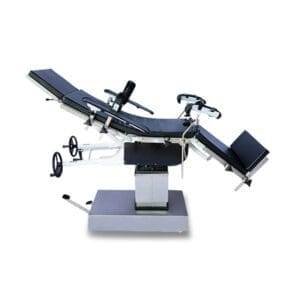Endereço
304 North Cardinal St.
Dorchester Center, MA 02124
Horas de trabalho
Segunda a sexta: 7h00 - 19h00
Fim de semana: 10h - 17h
Manual Operating Tables (OT Tables) have been a cornerstone of surgical practice in healthcare for decades. While automated technologies have made their way into the operating room, manual OT tables continue to hold a special place due to their unique advantages. In this comprehensive guide, we will explore the various benefits of manual OT tables and why they remain a preferred choice in healthcare settings.
The evolution of surgical technology has seen the introduction of advanced automated operating tables. However, manual OT tables continue to be a trusted choice in healthcare settings. In this article, we will explore the advantages that manual OT tables bring to the operating room and why they are preferred by many surgeons and healthcare facilities.
 Operating tables have come a long way since the early days of surgery. From simple wooden platforms to sophisticated hydraulic and motorized tables, the quest for precision and patient comfort has driven innovation. Manual OT tables represent a legacy of reliability and effectiveness in this journey.
Operating tables have come a long way since the early days of surgery. From simple wooden platforms to sophisticated hydraulic and motorized tables, the quest for precision and patient comfort has driven innovation. Manual OT tables represent a legacy of reliability and effectiveness in this journey.
One of the primary advantages of manual OT tables is the level of precision and control they offer to surgical teams. Surgeons can make real-time adjustments to the table’s height, tilt, and lateral tilt with ease. This precision is crucial for delicate surgical procedures, ensuring optimal patient positioning and access to the surgical site.
Manual OT tables are often more cost-effective than their automated counterparts. They have fewer mechanical components, reducing the risk of technical malfunctions. This cost savings is particularly appealing to healthcare facilities looking to manage expenses without compromising the quality of patient care.
In the high-stakes environment of surgery, reliability is paramount. Manual OT tables are known for their durability and robustness. They are less prone to technical issues and have a longer lifespan, making them a reliable choice for healthcare facilities.
Manual OT tables are versatile and can accommodate a wide range of surgical procedures. From orthopedic surgeries requiring precise positioning to cardiac procedures necessitating Trendelenburg positioning, manual OT tables adapt to various surgical needs.
 Customization and Precision
Customization and PrecisionWhile automated OT tables offer convenience, manual tables provide greater customization and precision. Surgeons can make minute adjustments during surgery, tailoring the table’s position to their specific needs.
Automated OT tables often require more extensive maintenance due to their complex electrical and mechanical components. This translates to higher maintenance costs over time. Manual OT tables, with their simplicity, are more cost-effective to maintain.
In critical situations where power outages or technical failures occur, manual OT tables shine. They do not rely on electricity or complex systems, ensuring that surgery can continue without interruption.
In this section, we will explore real-world applications of manual OT tables in healthcare settings and share case studies that highlight their advantages in various surgical procedures.
A1: Manual OT tables are versatile and suitable for a wide range of surgical procedures. However, for surgeries that require precise positioning and frequent adjustments, automated tables may be preferred.
A2: A well-maintained manual OT table can have a lifespan of 10 to 15 years or more, depending on usage and maintenance practices.
A3: Yes, manual OT tables are generally more cost-effective both in terms of initial purchase and long-term maintenance compared to automated tables.
Manual OT tables have stood the test of time in the ever-evolving field of healthcare. Their advantages in terms of precision, cost-effectiveness, reliability, and versatility make them a preferred choice for many surgeons and healthcare facilities. While automated technologies continue to advance, manual OT tables remain a testament to the enduring value of simplicity and effectiveness in the operating room.
